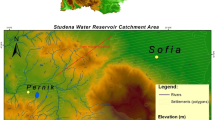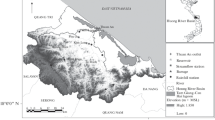Abstract
This paper proposes a decision support system for Yamchi reservoir operation in semi-arid region of Iran. The paper consists of the following steps: Firstly, the potential impacts of climate change on the streamflow are predicted. The study then presents the projections of future changes in temperature and precipitation under A2 scenario using the LARS-WG downscaling model and under RCP2.6, RCP4.5, and RCP8.5 using the statistical downscaling model (SDSM) in the northwestern of Iran. To do so, a general circulation model of HadCM3 is downscaled by using the LARS-WG model. As a result, the average temperature, for the horizon 2030 (2011–2030), will increase by 0.77 °C and precipitation will decrease by 11 mm. Secondly, the downscaled variables are used as input to the artificial neural network to investigate the possible impact of climate change on the runoffs. Thirdly, the system dynamics model is employed to model different scenarios for reservoir operation using the Vensim software. System dynamics is an effective approach for understanding the behavior of complex systems. Simulation results demonstrate that the water shortage in different sectors (including agriculture, domestic, industry, and environmental users) will be enormously increased in the case of business-as-usual strategy. In this research, by providing innovative management strategies, including deficit irrigation, the vulnerability of reservoir operation is reduced. The methodology is evaluated by using different modeling tests which then motivates using the methodology for other arid/semi-arid regions.












Similar content being viewed by others
References
Ahmad S, Prashar D (2010) Evaluation municipal water conservation policies using a dynamic simulation model. Water Resour Manag 24:3371–3395
Ahmadi A, Lafdani EK, Kianpisheh G (2014) Assessment of climate change impacts on rainfall using large scale climate variables and downscaling models: a case study. J Earth Syst Sci 7:1603–1618
Amir Rahmani M, Zarghami M (2015) The use of statistical weather generator, hybrid data driven and system dynamics models for water resources management under climate change. J Environ Inform 25(1):23–35
Arora VK, Boer GJ (2014) Terrestrial ecosystems response to future changes in climate and atmospheric CO2 concentration. Biogeosciences 11(15):4157–4171
Chen H, Guo J, Zhang Z, CY X (2012) Prediction of temperature and precipitation in Sudan and South Sudan by using LARS-WG in future. Theor Appl Climatol 113:375–363
Cunderlik JM, Simonivic SP (2004) Inverse modeling of water resources risk and vulnerability to changing climatic conditions. Water and climate change: knowledge for better adaptation. 57th Canadian water resources association annual congress, Montreal, QC, Canada
Dibike YB, Coulibaly P (2005) Hydrologic impact of climate change in the Saguenay watershed: comparison of downscaling methods and hydrologic models. J Hydrol 307(1–4):145–163
Felfelani F, Jalali Movahed A, Zarghami M (2013) Simulating hedging rules for effective reservoir operation by using system dynamics: a case study of Dez reservoir, Iran. Lake Reserv Manage 29:126–149
Ford A (1999) Modeling the environmental: an introduction to system dynamics modeling of environmental systems. Island, Washington, DC
Forrester JW (1971) Word dynamics. Wright-Allen, Cambridge
Ghasghaie M, Marofi S, Marofi H (2014) Using system dynamics method to determine the effect of water demand priorities on downstream flow. Water Resour Manag 28:5055–5072
Guo B, Zhang J, Gong H, Cheng X (2014) Future climate change impacts on the ecohydrology of Guishui river basin, China. Ecohydrol Hydrobiol 14:1
Hasanzadeh E, Zarghami M, Hasanzadeh Y (2012) Determining the main factors in declining the Urmia lake level by using system dynamics modeling. Water Resour Manag 26:129–145
Hashimoto T, Stedinger JR, Loucks DP (1982) Reliability, resiliency, and vulnerability criteria for water resource system performance evaluation. Water Resour Res 18(1):14–20
Hashmi MZ, Shamseldin AY, Melville B (2009) Statistical downscaling of precipitation: state-of-the-art and application of Bayesian multi model approach for uncertainty assessment. Hydrol Earth Syst Sci 6:6535–6579
Hassan Z, Shamsudin S, Harun S (2014) Application of SDSM and LARS-WG for simulating. Theor Appl Climatol 116(1):243–257
IPCC (2014) Climate change 2014: synthesis report. In: Pachauri RK, Meyer LA (eds) Contribution of working groups I, II and III to the fifth assessment report of the intergovernmental panel on climate change. Geneva, Switzerland, 151
Jakson, C, Sen, M (2009) Stochastic representation of parameter uncertainties within model predictions of future climate. Institute of Geophysics, University of texas at Austin, ig.utexas.edu
Khan MS, Coulibaly P, Dibike Y (2006) Uncertainty analysis of statistical downscaling methods. J Hydrol 319:357–382
Kieldsen TR, Rosbjerg D (2001) A framework for assessing the sustainability of a water resources system. Iahsh publication. p 107–114
Liu L, Liu Z, Ren X, Fischer T, Xu Y (2011) Hydrological impacts of climate change in the Yellow River basin for the 21st century using hydrological model and statistical downscaling model. Quatern Internat 244(2):211–220
Loucks DP, van Beek E (2005) Water resources systems planning and management-an introduction to methods, models and application. UNESCO/Delft Hydraulics, Paris
Madani K, Marino MA (2009) System dynamics analysis for managing Iran’s Zayandeh-Rud river basin. Water Resour Manag 23:2163–2187
Masah A, Morid S (2005) Climate change impacts on Isfahan Zayandeh-Rud River, Iran. J Sci Tech Agr Nat Resour 9:17–27 In persian
Mohammed IN, Bomblies A, Wemple BC (2015) The use of CMIP5 data to simulate climate change impacts on flow regime within the Lake Champlain Basin. Journal of Hydrology: Regional Studies 3:160–186
Prodanovic P, Simonovic SP (2010) An operational model for support of integrated watershed management. Water Resour Manag 24:1161–1194
Robock A, Turco RP, Harwell MA, Ackerman TP, Andressen R, Chang HS, Sivakumar MVK (1993) Use of general circulation model output in the creation of climate change scenarios for impact analysis. Clim Chang 23(4):293–335
Sattary MT, Ahmadifar V, Pashapur R (2014) Modeling of Alavian reservoir evaporation using tree M5 model and compare it with experimental methods. J Irrig Water Engin 5:110–122 In persian
Semenov MA, Barrow EM (2002) LARS-WG: a stochastic weather generator for use in climate impact studies. http://www.rothamsted.bbsrc.ac.uk/mas-models/larswg.html
Simonovic SP, Fahmy H (1999) A new approach for water resources policy analysis. Water Resour Res 35:295–304
Sterman JD (2000) Business dynamics: system thinking and modeling for a complex world. McGraw-Hill, Boston
Stouffer RJ, Manabe S, Bryan K (1989) Interhemispheric asymmetry in climate response to a gradual increase of atmospheric C02. Nature 342:660–662
Taylor KE, Stouffer RJ, Meehl GA (2012) An overview of CMIP5 and the experiment design. Bull Am Meteorol Soc 93(4):485–498
Wilby RL, Dawson CW, Barrow EM (2002) SDSM-A decision support tool for the assessment of regional climate change impacts. Environ Model Softw 17(2):147–159
Winz I, Brierley G, Trowsdale S (2009) The use of system dynamics simulation in water resources management. Water Resour Manag 23:1301–1323
Xi X, Poh KL (2015) A novel integrated decision support tool for sustainable water resources management in Singapore: synergies between system dynamics and analytic hierarchy process. Water Resour Manag 29:1329–1350
Xu ZX, Takeuchi K, Ishidaira H, Zhang XW (2002) Sustainability analysis for Yellow River water resources using the system dynamics approach. Water Resour Manag 16:239–261
Yang CC, Chang LC, Ho CC (2008) Application of system dynamics with impact analysis to solve the problem of water shortages in Taiwan. Water Resour Manag 22:1561–1577
Yang T, Li H, Wang W, CY X, Yu Z (2012) Statistical downscaling of extreme daily precipitation, evaporation, and temperature and construction of future scenarios. Hydrol Process 26(23):3510–3523
Yang J, Lei K, Khu S, Meng W (2015) Assessment of water resources carrying capacity for sustainable development based on a system dynamics model. Water Resour Manag 29:885–899
Yazdani V, Ghahraman B, Davari K (2010) Determination of the best experimental method to estimate the evaporation of Amol farmlands, Iran, based on the sensitivity analysis and compare it with ANN results. J Iran Water Res 4:47–58 In persian
Zarghami M, Abdi A, Babaeian I, Hassanzadeh Y, Kanani R (2011) Impacts of climate change on runoffs in East Azerbaijan, Iran. Glob Planet Chang 78(3–4):137–146
Zhang Y, You Q, Chen CH, Ge J (2016) Impacts of climate change on streamflows under RCP scenarios: a case study in Xin River basin, China. Atmos Res 178–179:521–534
Acknowledgments
This research is supported by Ardabil Regional Water Authority and then their funding is appreciated.
Author information
Authors and Affiliations
Corresponding author
Additional information
This article is part of the Topical Collection on Water Resources in Arid Areas
Rights and permissions
About this article
Cite this article
Zarghami, M., Fotookian, M.R., Safari, N. et al. Reservoir operation using system dynamics under climate change impacts: a case study of Yamchi reservoir, Iran. Arab J Geosci 9, 678 (2016). https://doi.org/10.1007/s12517-016-2676-3
Received:
Accepted:
Published:
DOI: https://doi.org/10.1007/s12517-016-2676-3




